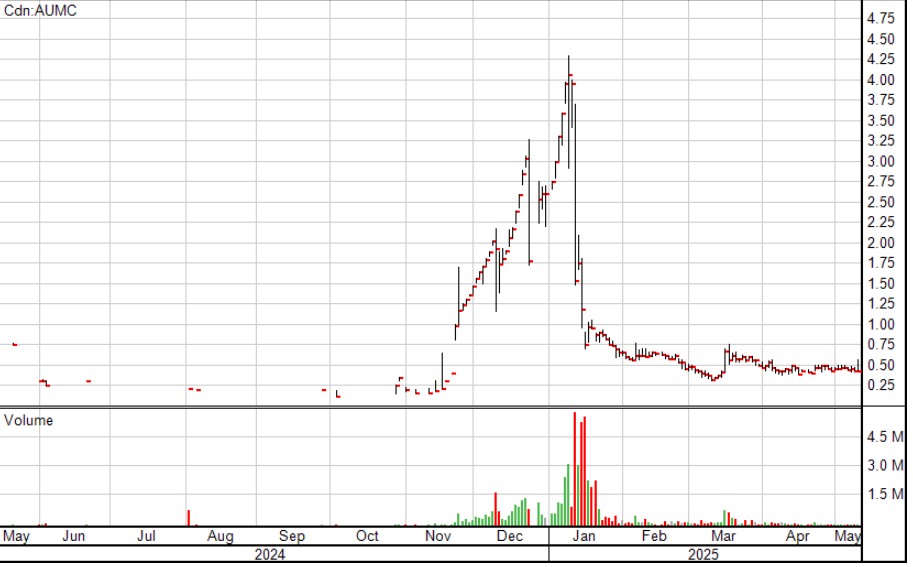The saga of Auric Minerals (AUMC:CSE $0.46 CDN – May 2025) serves as a stark reminder of how aggressive promotion, questionable fundamentals, and the potential for insider maneuvering can create a perfect storm for unsuspecting investors. This article will analyze the events surrounding AUMC’s price surge and subsequent collapse, highlighting the tactics used and the lessons that investors can learn from this cautionary tale.
AUMC’s Sudden Rise: The Uranium Hype
Heading into November 2024, Auric Minerals was a relatively unknown penny stock with a tight share structure (around 15 million shares outstanding) and VERY limited cash reserves. On November 14th, the company announced an agreement to acquire a uranium exploration project in eastern Canada. This announcement, though lacking in specifics, ignited a firestorm of promotional activity.
The Chart Tells a Story:

The Promotional Machine and Questionable Fundamentals
While the acquisition of a uranium project might seem promising on the surface, the lack of concrete details and the company’s reportedly weak financial position should have raised red flags. The aggressive promotional campaign that followed the announcement, with no other relevant news, suggested an attempt to artificially inflate the stock price – on the part of, and to the benefit of (??).
A “Possible” Scenario: Selling by Those “Associated” With Insiders and a Looming Financing
The rapid price increase likely presented a golden opportunity for insiders or those closely associated with the company (control group) to sell significant amounts of stock at inflated prices. This is a common tactic in the penny stock space, particularly when a company is in need of capital.
The subsequent price collapse “suggests” that selling pressure from a “control group”, coupled with a likely lack of genuine buying interest at the elevated levels, overwhelmed the speculative demand.
The typical pattern following such events is for the company to announce a financing, often at a price significantly below the recent highs and including warrants. This allows them to raise capital, often after a control group has taken profits, while further diluting existing shareholders. It is common for a financing to be pre-arranged with a broker, or brokers, who may also participate in the selling – either personally or for their clients.
However, it is also important to keep the following in mind. If a penny stock runs high enough and beyond what the control group was expecting, it may not be uncommon for them to (only) raise a “token” amount of money. Enough to do some field work (in the case of a resource exploration company) which may or may not include some drilling.
Often, insiders, promoters, brokers and friends, will make enough money during the stock promotion, that there is little reason (in their mind) to do any “real” work. In particular, and very relevant to penny stocks, mineral / metals exploration is very expensive and few management / insider groups have the motivation or “skillset” to pull off an economic discovery. It is far easier to promote a “story” than build a mine. And if their stock promotion went well, they will pocket a LOT of $$ in the process.
Red Flags and Lessons Learned:
The Auric Minerals case highlights several red flags that investors should be aware of:
- Sudden Price Spikes with No Fundamental Basis: Be wary of rapid price increases that are not supported by significant news or improvements in the company’s fundamentals.
- Aggressive Promotion: Excessive promotion, especially when lacking in substance, is often a sign of manipulation.
- Weak Financials: Companies with little cash and high burn rates are more likely to engage in dilutive financings.
- Tight Share Structure Followed by High Volume: A low float can make a stock more susceptible to manipulation, and a sudden increase in volume after a period of being tightly held can indicate insider selling.
- Lack of Transparency: Vague announcements and a lack of detailed information about a project or acquisition are warning signs.
Conclusion
The Auric Minerals story is a cautionary tale for anyone venturing into penny stocks. It underscores the importance of due diligence, skepticism, and a healthy understanding of the tactics often employed by promoters and insiders. While the allure of quick profits can be tempting, investors must remember that fundamentals ultimately drive long-term value. Chasing hype and ignoring red flags can lead to significant losses. The microcap space can offer legitimate opportunities, but it’s crucial to approach it with caution, a critical eye, and a commitment to thorough research. The AUMC example serves as a potent reminder that in the world of penny stocks, if it seems too good to be true, it probably is. This is also a reminder to be aware of a potential financing once a stock has had an unusual, and likely unsustainable, spike in price and volume.
